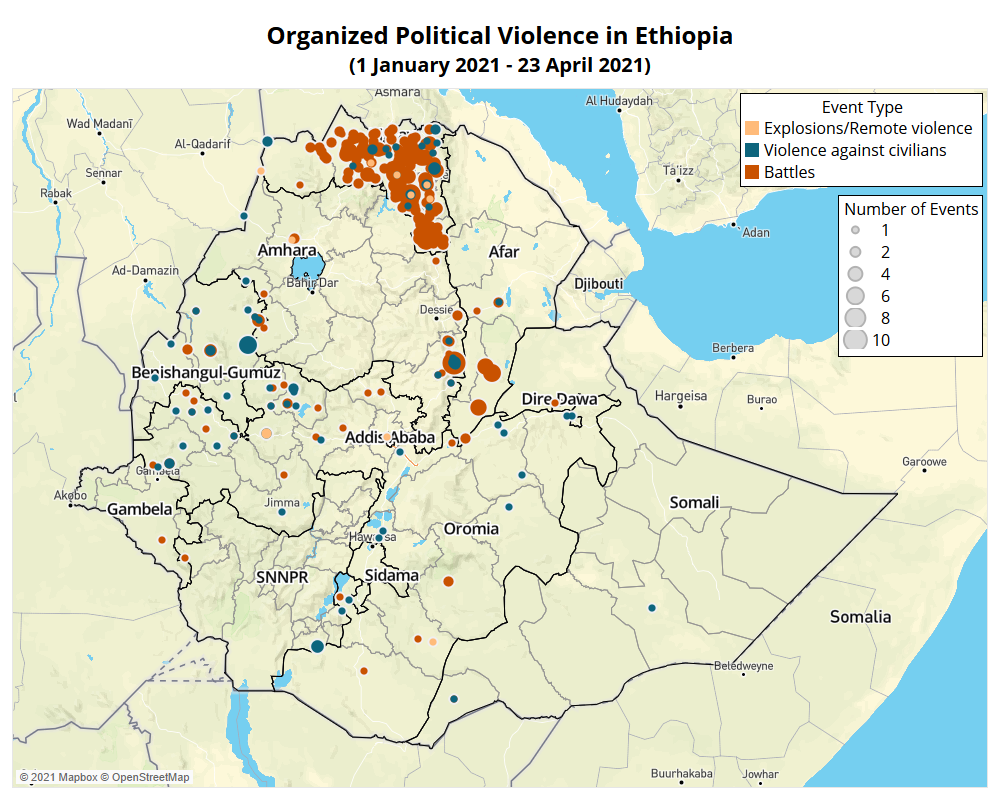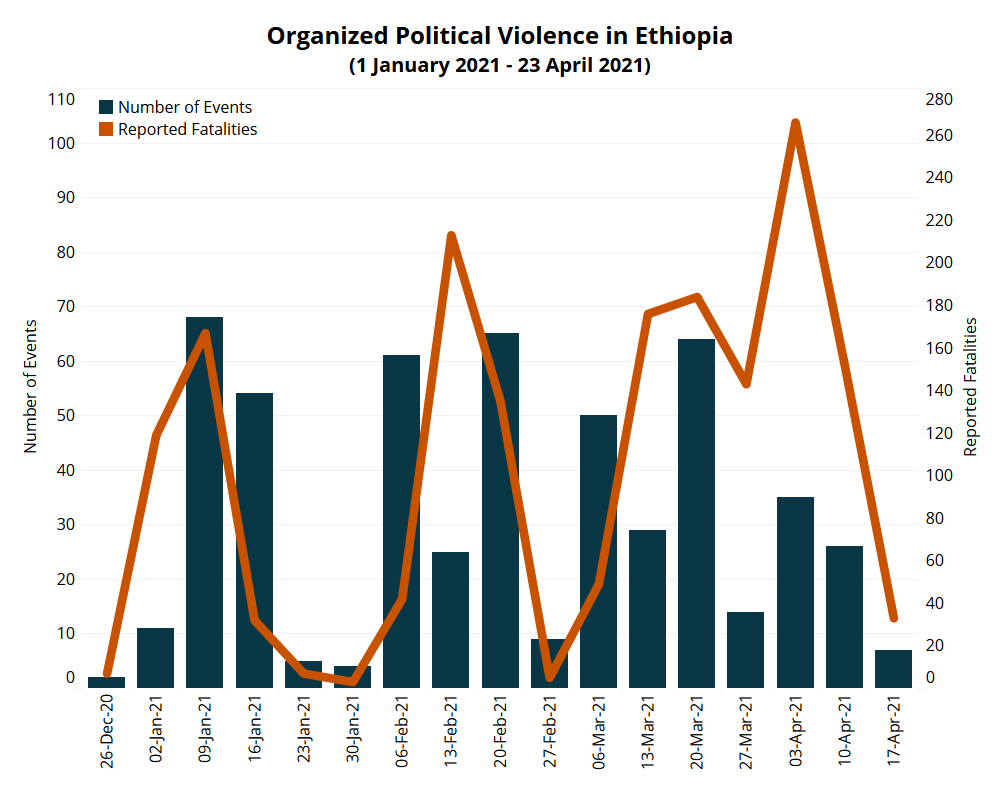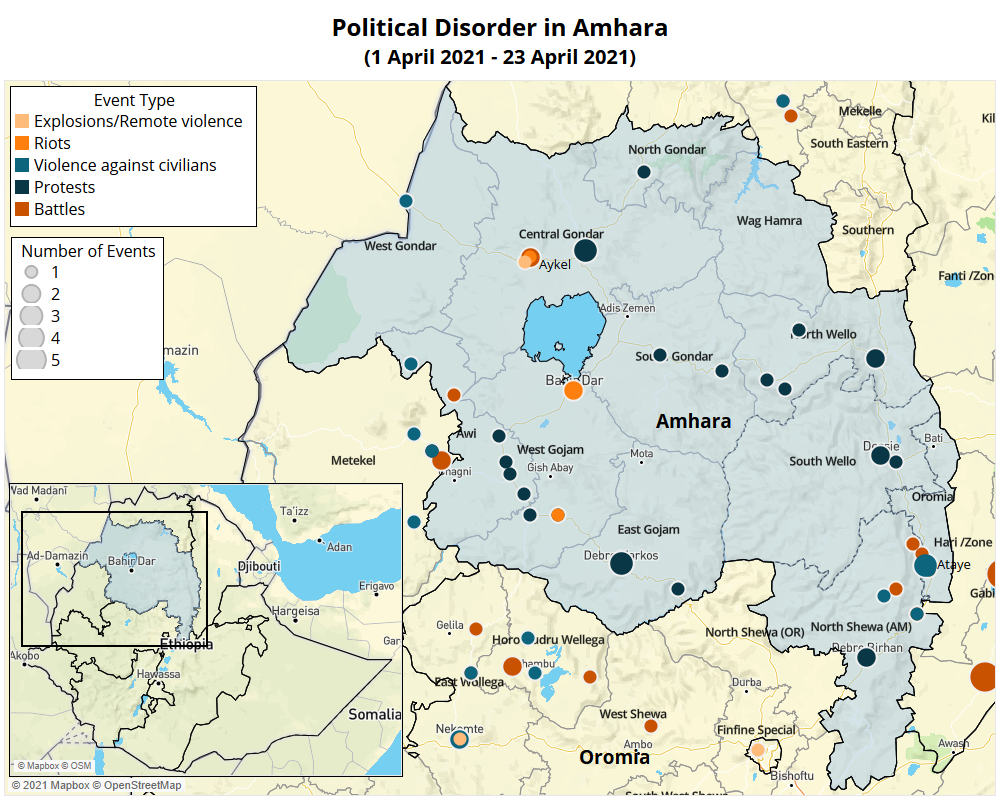By the Numbers: Ethiopia, 2 April 2018-23 April 20211Figures reflect violent events reported since Prime Minister Abiy Ahmed came to power on 2 April 2018.
- Total number of organized violence events: 1,502
- Total number of reported fatalities from organized violence: 6,967
- Total number of reported fatalities from civilian targeting: 3,819
Ethiopia data are available through a curated EPO data file as well as the main ACLED export tool.

Situation Summary
Last week, demonstrations were held in major towns across Amhara region, denouncing violent attacks by different actors and the displacement of Amhara civilians across the country. Demonstrators carried slogans urging the government to fulfill its responsibility to ensure the safety of citizens, with some denouncing the incumbent Prosperity Party’s alleged links with Oromo extremist groups. While most demonstrations were peaceful, on the third day of demonstrations, demonstrators clashed with security forces trying to disperse them in Bahir Dar city.
In Benshangul/Gumuz, suspected militants from the Gumuz People’s Democratic Movement took “nearly full control” of Sedal Woreda, including the administrative center Diza, overrunning local security forces (Ethiopian Human Rights Commission, 21 April 2021).
In Central Gondar, Amhara region, suspected militants from a Qimant ethno-nationalist group clashed with Amhara regional special police in the vicinity of Aykel town (Chilga), prompting the deployment of national forces and additional security troops into the area.
In Oromia region, clashes between Amhara and Oromo ethnic militias continued in Mender 8, Mender 9, Mender 10, and Arkumbi vicinities of Ayana. Reports indicate that Oromo Liberation Front (OLF)-Shane militias were involved, and a number of Amhara civilians were killed following the clashes. Federal forces continued to battle OLF-Shane forces across Western Oromia.
Finally, in Tigray region, the Tigrayan People’s Liberation Front (TPLF) forces and associated Tigray militias clashed with Ethiopian and Eritrean forces in several areas of the region.

Tigray Conflict Update
In the Tigray region, sporadic clashes occurred in several areas as TPLF associated forces battled against Ethiopian and Eritrean forces. The United Nations Security Council released a statement acknowledging the efforts of the Ethiopian government to provide humanitarian assistance, but noted the continuing insecurity was hindering humanitarian operations (UNSC Press Statement on Ethiopia, 22 April 2021). In addition, on 22 April 2021, two top leaders of the Salsay Weyane Tigray party were arrested in Mekele city (DW Amharic, 23 April 2021). Even though the reason for their arrest was not made known, the party stated that their arrest is political and linked to their protest against the current insecurity of Tigray people in Tigray region. The Salsay Weyane Tigray party, established after Prime Minister Abiy Ahmed came to power, is one of the four opposition parties that took part in the September 2020 Tigray regional election that was deemed illegal by the federal government.
Regional Focus: Demonstrations Against Targeted Killings and Displacement of Amharas in Amhara Region
Frustration with the Ethiopian government over their perceived lack of action in regard to the targeted killing and displacement of Amhara civilians by different actors throughout Ethiopia has contributed to an atmosphere of growing discontent in the Amhara region over the past two years. Demonstrations were sparked last week when violence in the North Shewa and Oromo zone of the Amhara region reached a new peak following the previous clashes between Oromo and Amhara communities in the Oromo zone of Amhara region and surrounding towns from 18 to 31 March. A group of gunmen — believed to be a combination of militants from the Oromo Liberation Front (OLF)-Shane and local Oromo militias — attacked the towns of Ataye Shewa Robit, Karakore, Mekoya (Antsokiya), Ephrata Gidim, and Majete (for more details, see last week’s EPO-Weekly). Violent clashes and ethnically-targeted killing have led to an estimated 350 fatalities and 328,000 people being internally displaced from 18 to 31 March and from 16 to18 April 2021 (DW Amharic, 22 April 2021, Africa News, 4 April 2021, Reuters, 20 April 2021).
Demonstrations began in Dessie and Debre Markos on the 19 April and later spread to Bahir Dar, Weldiya, Finote Selam, Kombolcha, Debre Birhan, Welo, Lalibela, Kon, Wadla, Gondar, Injibara, Debark, Denbecha, Enarj ena Enawera, Debre Werk, Dejen, Dangila, Bure, Addis Kidame, Tilili, Bichena, and Sekota cities of Amhara region (see map below) (Ethiopian Broadcasting Corporation, 20 April 2021; Amhara Media Corporation, 20 April 2021; 21 April 2021; 22 April 2021a; 22 April 2021b; 23 April 2021; Addis Standard, 20 April 2021; DW Amharic, 24 April 2021; 25 April 2021). Throughout the week, demonstrators urged the government to fulfill its responsibility to ensure the safety of citizens and to bring to justice the perpetrators of such violence.

While most demonstrations remained peaceful, the demonstrations contained direct anti-government messaging and Amhara ethno-nationalist slogans that accused the Oromo Prosperity Party2The Prosperity Party is organized along ethnic lines and includes an Oromo Prosperity Party wing and an Amhara Prosperity Party wing, among others. of perpetrating violence in Ataye and the surrounding area (for more details on violence in this area see EPO Weekly: 10-16 April 2021 and EPO Weekly: 27 March-2 April 2021). On the first day of the demonstration in Bahir Dar city, for example, demonstrators chanted slogans accusing Prime Minister Abiy Ahmed of being linked to OLF-Shane; they burned the Prosperity Party’s billboards (Addis Standard, 20 April 2021). In some cases, the demonstrations even took on an anti-Oromo tone, with some demonstrators holding signs saying, “Destroy Oromuma.” This act was condemned by some Oromo politicians and Abba Gadaa leaders (Oromo traditional elders) (Oromia Communication Bureau, 24 April 2021; OMN, 21 April 2021; Taye Dendea Aredo, 20 April 2021). The Amhara regional government also condemned such acts. The regional government stated that even though most demonstrations were peaceful, some “extreme forces” wanted to “hijack” the demonstration by taking actions that were intended to “creates hate, distrust” and sever the relationship between Amhara and Oromo ethnic groups (Amhara Communications, 21 April 2021; Amhara Communication, 23 April 2021).
In Bahir Dar, demonstrations turned violent on the third day when protesters blocked roads and clashed with security forces who tried to disperse them. According to reports, four demonstrators, as well as 30 security forces, were injured (DW Amharic, 23 April 2021; Amhara Communication, 23 April 2021). Authorities later stated that the regional government recognizes the demands of the demonstrators and is working together with the Oromia regional government to take appropriate measures (Amhara Communications, 21 April 2021).
Continued violence targeting ethnic Amhara throughout the country is deeply damaging to the Prosperity Party’s ability to retain voter confidence in Amhara region. Even staunch supporters of the Prosperity Party recognize problematic divides between the Amhara and Oromo camps of the party. The recent unprecedented levels of violence in March and April 2021 in Amhara region appear to be a tipping point for voters who no longer feel confident that the Amhara Prosperity Party can provide security for the state. Discontent and frustration towards the government’s lack of or delayed response to attacks on ethnic Amhara throughout Ethiopia has driven deep divides between the Oromo and Amhara regional governments, who trade blame for the breakdown in security.
There is also a sense that the ethno-nationalist party — the National Movement of Amhara (NaMA) — is gaining ground given the perceived incompetence of the Amhara Prosperity Party officials to solve the issue. This has caused alarm for ethnic minorities within the Amhara regional state, namely the Qimant, who clashed with Amhara regional special forces throughout last week after a town hall meeting turned violent, resulting in the deaths of 32 people (Addis Standard, 22 April 2021; Amhara Communication, 23 April 2021; Amhara Media Corporation, 19 April 2021).
Election-related Dispute and Violence
Last week, two top party members of different political parties were killed in Amhara region. These killings are linked to the recent instability in the region. Around 16 April 2021, an Ethiopian Citizens for Social Justice (EZEMA) party candidate for Eferatana Gidem woreda (North Shewa, Amhara region) was killed by an unidentified armed group in Ataye town during clashes between OLF-Shane (and local Oromo militias) and the Amhara regional special forces and federal troops (Ethiopian Citizens for Social Justice, 21 April 2021).On 21 April 2021, a NaMA party member, who was the leader of the party’s youth organization, was shot and killed in Metema (West Gondar, Amhara region) (National Movement of Amhara, 22 April 2021). Election-related violence has continued to increase as the election draws near.






